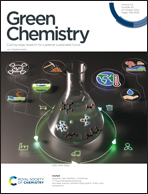Rapid synthesis of metal nanoparticles using low-temperature, low-pressure argon plasma chemistry and self-assembly
Abstract
The synthesis of metal nanoparticles has become a priority for the advancement of nanotechnology. In attempts to create these nanoparticles, several different methods: chemistry, physics, and biology, have all been used. In this study, we report the reduction of cations using argon plasma chemistry to produce nanoparticles of gold (AuNPs), silver (AgNPs), and copper (CuNPs). Although other groups have used plasma-reduction methods to synthesize metal nanoparticles from their cation counterparts, these approaches often require plasma|liquid state interactions, high temperature, specific combinations of gases, and extended treatment times (>10 minutes), for which only specific cations (noble or non-noble) may be reduced. As a result, we have developed a non-thermal, low-pressure argon-plasma|solid state approach for the reduction of both noble and non-noble cations. More specifically, when 50 μL droplets of 2 mM solutions of gold(III) chloride, silver nitrate, or copper(II) sulfate are exposed to vacuum, they undergo an evaporation process. As the pressure in the chamber decreases to 220 mTorr, the droplets become completely evaporated, leaving behind a metal precursor. Nucleation and growth studies reveal that when the metal precursors of gold(III) chloride, silver nitrate, and copper(II) sulfate are treated with 80 watts of argon plasma for 5, 60, and 150 seconds, respectively, nanoparticles could be synthesized with efficiency rates of upwards of 98%. The size of nanoparticles synthesized in this work was studied using Scanning Electron Microscopy, and the scattering properties of the nanoparticles was studied using UV/Vis spectroscopy. Transmission Electron Microscopy with corresponding elemental analysis was also very useful in confirming the identity of the synthesized nanoparticles. The results from this study reveal that we have synthesized metal nanoparticles with distinct chemical and physical properties. Scanning Electron Microscopy depicts AgNPs with a round-shape and diameters from 40–80 nm, while AuNPs were hexagonal, with sizes from 40–80 nm, and CuNPs were rod-shaped, with dimensions 40 by 160 nm. Our findings demonstrate that the argon plasma approach used in this study is a rapid, green, and versatile reduction method for the synthesis of both noble and non-noble metal nanoparticles.



 Please wait while we load your content...
Please wait while we load your content...